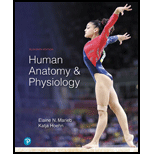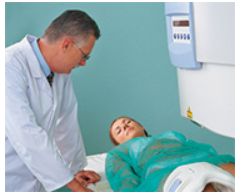
45-Year-Old Female with Dislocated Hip
Kayla Tanner, a 45-year-old mother of four, was involved in a car accident. When emergency responders arrived on the scene and extracted her from the car, they found that her right thigh appeared shorter than her left thigh. They also noticed that even slight hip movement caused considerable pain. Suspecting a hip dislocation, they stabilized and transported her.

In the emergency department, doctors discovered a decreased ability to sense light touch in her right foot, and she was unable to move her toes or ankle. Dislocation of her right hip was confirmed by X ray. Mrs. Tanner was sedated to relax the muscles around the hip. and then doctors placed her in the supine position and performed a closed reduction (“popped” the femur back in place).
5. NCLEX-STYLE Mrs. Tanner is discussing her injury with you during recovery. Which of her remarks indicate a need for additional education about her injury?
a.“I dislocated my shoulder twice. I guess this hip injury is just the same sort of thing–I’m surprised it hasn’t happened before. I’m sort of nervous that it could just slip out any time!”
b.“I didn’t realize that so many of the hip bones were fused together.”
c.“The bottom of my spinal column is really different from the top!”
d.“When you look at how tight those connections are, it’s easy to see why I can’t move my leg around at the hip the way I move my arm around at the shoulder.”
Want to see the full answer?
Check out a sample textbook solution
Chapter 7 Solutions
Human Anatomy & Physiology (11th Edition)
- Imagine you are a botanist. Below are characteristics of a never-before described plant species recently identified as part of the ‘All Taxa Biodiversity Inventory’ (ATBI). Field Notes: Specimen collected from shaded area along stream in South Cumberland State Park (Grundy County, TN). Laboratory Analysis: Body: Large leaves emerging from underground rhizome. Size: 63 cm Chromosomal Analysis: Plant body is diploid—chromosome number of 44. Lignin test: Positive Cuticle: Present Leaves: Present—large with branched veins. Underside has sori (containing haploid spores). Roots: Present—branch from the inside. Stem: Present—vascular tissue (xylem & phloem) present. Life History: Diploid sporophyte dominant generation. Haploid spores germinate into heart-shaped, haploid, gametophyte. Water required for fertilization; no seed is produced. Diploid zygote develops into sporophyte. Explain which domain, kingdom and phylum you believe this plant should be classified…arrow_forwardCUÁ Glycine A C C Newly formed molecule Glycine Arginine Proline Alanine A C C CC G GGAUUGGUGGGGC Structure X I mRNAarrow_forwardAdaptations to a Changing Environment Why is it necessary for organisms to have the ability to adapt? Why is the current environment making it difficult for organisms like the monarch butterfly to adapt? Explain how organisms develop adaptations.arrow_forward
- Artificial Selection: Explain how artificial selection is like natural selection and whether the experimental procedure shown in the video could be used to alter other traits. Why are quail eggs useful for this experiment on selection?arrow_forwardDon't give AI generated solution otherwise I will give you downwardarrow_forwardHello, Can tou please help me to develope the next topic (in a esquematic format) please?: Function and Benefits of Compound Microscopes Thank you in advance!arrow_forward
- Identify the AMA CPT assistant that you have chosen. Explain your interpretation of the AMA CPT assistant. Explain how this AMA CPT assistant will help you in the future.arrow_forwardwhat is the difference between drug education programs and drug prevention programsarrow_forwardWhat is the formula of Evolution? Define each item.arrow_forward
- Define the following concepts from Genetic Algorithms: Mutation of an organism and mutation probabilityarrow_forwardFitness 6. The primary theory to explain the evolution of cooperation among relatives is Kin Selection. The graph below shows how Kin Selection theory can be used to explain cooperative displays in male wild turkeys. B When paired, subordinant males increase the reproductive success of their solo, dominant brothers. 0.9 C 0 Dominant Solo EVOLUTION Se, Box 13.2 © 2023 Oxford University Press rB rB-C Direct Indirect Fitness fitness fitness gain Subordinate 19 Fitness After A. H. Krakauer. 2005. Nature 434: 69-72 r = 0.42 Subordinant Dominant a) Use Hamilton's Rule to show how Kin Selection can support the evolution of cooperation in this system. Show the math. (4 b) Assume that the average relatedness among male turkeys in displaying pairs was instead r = 0.10. Could kin selection still explain the cooperative display behavior (show math)? In this case, what alternative explanation could you give for the behavior? (4 pts) 7. In vampire bats (pictured below), group members that have fed…arrow_forwardExamine the following mechanism and classify the role of each labeled species in the table below. Check all the boxes that applyarrow_forward
- Surgical Tech For Surgical Tech Pos CareHealth & NutritionISBN:9781337648868Author:AssociationPublisher:Cengage
 Medical Terminology for Health Professions, Spira...Health & NutritionISBN:9781305634350Author:Ann Ehrlich, Carol L. Schroeder, Laura Ehrlich, Katrina A. SchroederPublisher:Cengage Learning
Medical Terminology for Health Professions, Spira...Health & NutritionISBN:9781305634350Author:Ann Ehrlich, Carol L. Schroeder, Laura Ehrlich, Katrina A. SchroederPublisher:Cengage Learning




